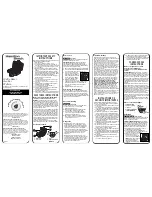
14
ICE MAKER USER MANUAL
ICE MAKER USER MANUAL
15
ICE MAKER INSTALLATION
OPERATION
MOBILE INSTALLATION:
ICE MAKING STAGE
ICE MAKING STAGE
BIN FULL STAGE
ENCLOSED INSTALLATION:
BUILT-IN INSTALLATION:
INSTALLATION TYPES
FINAL CHECK LIST BEFORE OPERATION
OPERATING METHOD
A mobile installation will allow you to install the ice maker free-standing in any place you desire provided
you have access to a water supply. You must follow the stated instructions for:
a. Electrical requirements
b. Water supply
c. Leveling the ice maker.
An enclosed installation will allow you to install the ice maker under a cabinet or in a kitchen cabinet
provided the required clearance space around the ice maker is respected. This installation has the same
requirements as a mobile installation.
If this method of installation is chosen, it will still be necessary to allow adequate ventilation space around
the unit. The following additional items must be observed.
1. Place ice maker in front of installation location. Remove the feet and place the unit flat on the floor or on
a platform depending on your installation requirements.
2. The water supply line must be plumbed before connecting to the ice maker.
3. Turn on main water supply and tap. Check for water supply connection leaks. Tighten every connection
(including connection at the water inlet).
4. If the electrical outlet for the ice maker is behind the cabinet, plug in the ice maker.
5. Push the ice maker into position.
6. Seal all around the cabinet to the floor with an approved caulking compound.
1. Have all packing materials and tape been removed from the interior and exterior of the ice maker?
2. Did you clean the ice storage bin?
3. Have the installation instructions been followed, including connecting the machine to water and
electricity?
4. Has the machine been leveled?
5. Is the ice maker in a site where the ambient temperature is between 45°F (7°C) and 110°F (43°C) and the
water temperature between 41°F (5°C) and 90°F (32°C) all yearround?
6. Has the water supply pressure been checked to ensure a minimum of 15 psig with a static pressure not
to exceed 80 psig?
7. Is there a clearance of at least 4” (102mm) at the rear, and 1” (25 mm) at top and sides for proper air
circulation?
8. Has the power supply voltage been checked or tested against the nameplate rating?
And has proper grounding been installed in the ice maker?
9. Is the ice maker plugged in?
10. Have you turned on the main water supply and tap?
11. Have you checked for leaks at all water supply connections?
1. Turn on the water tap, let the water trough fill, then press the ON/OFF button on the front panel. The ice
maker will start working automatically.
2. After 3 minutes, the machine will automatically go to the ice-making stage, and the sound of water
flowing will be heard.
3. When the batch of ice has been fully formed, ice will automatically be harvested to the ice storage bin.
4. When the ice storage bin is full, the sheet of cubes will not fall completely and will hold the bin-full probe
open. The machine stops making ice automatically.
5. The unit will start making ice again after the ice cubes are removed. Then the bin-full probe swings back
to operating position.
This ice maker has been designed for Mobile (free-standing) installation. However, it can also be Enclosed
(as under a cabinet) or Built-in (sealed to the floor). In any case, there must be adequate air space around
the unit for ventilation.
IMPORTANT:
Be sure the drain hose is connected and fed into the drain line before the ice maker
is moved into its final position.
IMPORTANT:
• Although the unit has been tested and cleaned at the factory, due to long-term transit and storage, the
first batch of cubes must be discarded.
• Never turn the water supply tap off when the ice maker is working.
• Never touch evaporator when unit is running!
• Except to take ice from the unit, keep the door closed to reduce melting and insure proper ice
formation.
Summary of Contents for SSIM-15
Page 1: ...ICE MAKER USER MANUAL ...

































